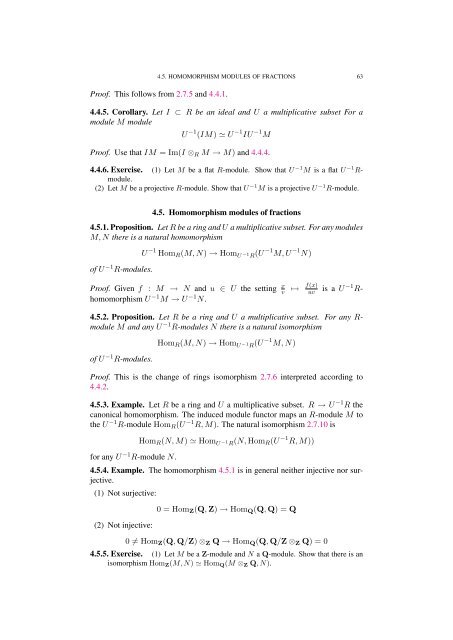Commutative algebra - Department of Mathematical Sciences - old ...
Commutative algebra - Department of Mathematical Sciences - old ...
Commutative algebra - Department of Mathematical Sciences - old ...
You also want an ePaper? Increase the reach of your titles
YUMPU automatically turns print PDFs into web optimized ePapers that Google loves.
4.5. HOMOMORPHISM MODULES OF FRACTIONS 63<br />
Pro<strong>of</strong>. This follows from 2.7.5 and 4.4.1.<br />
4.4.5. Corollary. Let I ⊂ R be an ideal and U a multiplicative subset For a<br />
module M module<br />
U −1 (IM) U −1 IU −1 M<br />
Pro<strong>of</strong>. Use that IM = Im(I ⊗R M → M) and 4.4.4.<br />
4.4.6. Exercise. (1) Let M be a flat R-module. Show that U −1 M is a flat U −1 Rmodule.<br />
(2) Let M be a projective R-module. Show that U −1 M is a projective U −1 R-module.<br />
4.5. Homomorphism modules <strong>of</strong> fractions<br />
4.5.1. Proposition. Let R be a ring and U a multiplicative subset. For any modules<br />
M, N there is a natural homomorphism<br />
<strong>of</strong> U −1 R-modules.<br />
U −1 HomR(M, N) → Hom U −1 R(U −1 M, U −1 N)<br />
Pro<strong>of</strong>. Given f : M → N and u ∈ U the setting x<br />
homomorphism U −1 M → U −1 N.<br />
v ↦→ f(x)<br />
uv is a U −1R 4.5.2. Proposition. Let R be a ring and U a multiplicative subset. For any Rmodule<br />
M and any U −1 R-modules N there is a natural isomorphism<br />
<strong>of</strong> U −1 R-modules.<br />
HomR(M, N) → Hom U −1 R(U −1 M, N)<br />
Pro<strong>of</strong>. This is the change <strong>of</strong> rings isomorphism 2.7.6 interpreted according to<br />
4.4.2.<br />
4.5.3. Example. Let R be a ring and U a multiplicative subset. R → U −1 R the<br />
canonical homomorphism. The induced module functor maps an R-module M to<br />
the U −1 R-module HomR(U −1 R, M). The natural isomorphism 2.7.10 is<br />
for any U −1 R-module N.<br />
HomR(N, M) Hom U −1 R(N, HomR(U −1 R, M))<br />
4.5.4. Example. The homomorphism 4.5.1 is in general neither injective nor surjective.<br />
(1) Not surjective:<br />
(2) Not injective:<br />
0 = HomZ(Q, Z) → HomQ(Q, Q) = Q<br />
0 = HomZ(Q, Q/Z) ⊗Z Q → HomQ(Q, Q/Z ⊗Z Q) = 0<br />
4.5.5. Exercise. (1) Let M be a Z-module and N a Q-module. Show that there is an<br />
isomorphism HomZ(M, N) HomQ(M ⊗Z Q, N).
















